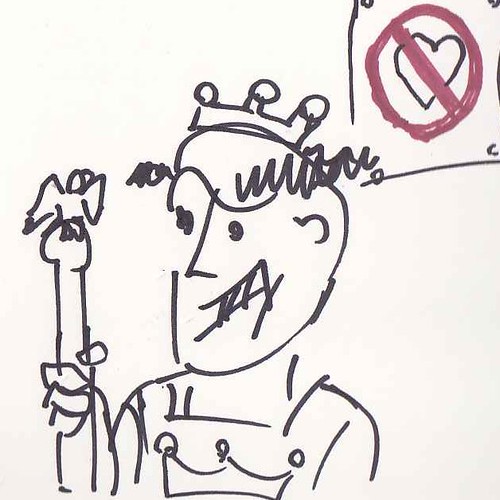I went to a big Regional Fighter Practice today and got authorized to fight rapier! Woo! Sean cam e with me, as did Faith, and the rest of the Glees hung out with my mom. Sean got to put a trebuchet together, then realize it was unusable due to a hardware failure, then went to get the parts to fix it and then he fixed it! Because he's smart, see. He also shot a crossbow!
Faith spent her time hanging with a girl named Natalie and building elaborate waterworks by the pond onsite. Then some jerky older boys came along and destroyed their stuff! Grr! Faith has had very limited exposure to that bane of children everywhere, the Common Bully. She was angry but relatively unruffled by the time she told me about it.
I'm sunburned and happy. Now on to armor/garb.
Sunday, February 27, 2011
Wednesday, February 23, 2011
embarrassingly enthusiastic
I'm such a dork about this fencing stuff, I know.
So practice went well. I used dagger and rapier this time instead of rapier alone. The dagger is used for defense and offense and I liked it. Not that I did especially well with it or anything. I have a hard time telling where it is in my hand, so I would parry with the flat instead of the edge.
My rapier and blunts came. I love my rapier very much.
So practice went well. I used dagger and rapier this time instead of rapier alone. The dagger is used for defense and offense and I liked it. Not that I did especially well with it or anything. I have a hard time telling where it is in my hand, so I would parry with the flat instead of the edge.
My rapier and blunts came. I love my rapier very much.
Tuesday, February 22, 2011
updated musings
My rapier will be here tomorrow! I hope it gets here in ime for me to bring it to practice tomorrow evening. I probably can't use it to spar with, because I don't have a safety blunt for the tip, but I want to show it off anyway.
I have been reading Agrippa and Capo Ferro and studying their diagrams. And watching rapier videos aon YouTube. I am struck (har har) by the elegance and inevitability of the moves, countermoves, and counter-counter moves. (there are actual names for them, I can't remember or don't quite understand yet.) The way it all goes together, like a sonnet or like a chess match.
I also ordered a mask.
I have been reading Agrippa and Capo Ferro and studying their diagrams. And watching rapier videos aon YouTube. I am struck (har har) by the elegance and inevitability of the moves, countermoves, and counter-counter moves. (there are actual names for them, I can't remember or don't quite understand yet.) The way it all goes together, like a sonnet or like a chess match.
I also ordered a mask.
Sunday, February 20, 2011
A Really Short History of Nearly Everything, by Bill Bryson

This is great! I read the book it's based on, Bryson's A Short History of Nearly Everything
Highly recommend.
Friday, February 18, 2011
Poetry Friday: Happy Faustine's Day
Every February 15th, I pledge my love to my Faustine, Sean. And every year he returns the favor. I have learned that the Faustine's Day holiday is not universally celebrated, which confuses me, because it is a feast of a Roman martyr (and his brother, Jovita), beheaded by Hadrian. I am told there is some other such martyr who has a feast about the same time, who seems to get a lot more attention.
Anyhoo, the great thing about Faustine's Day is there are frequently excellent sales on the sort of thing one would give one's beloved: heart-shaped chocolates, flowers, pink teddy bears, and so forth. One thing lacking every single year, however, are Faustine cards. Sean always makes me one, with an illustrated poem, which follows.
Faustine, Hero of Love
by Sean Gleeson


Long ago, in Roman days
Faustine went to and fro
To spread God's love, His word and ways,
And Jovita, Faustine's bro.

On the city streets he'd preach,
And the alleyways thereof.
"Amo, Amas, Amat," he'd teach.
I love, you love, He loves.

But the man in charge was bad
Hadrian the Great.
The emperor was spitting mad!
Haters gonna hate.

"I shall kill Faustinus dead
To stop his words of love!
Make a trophy of his head!
Jovita's too, by Jove!"

Faustine chuckled at the king.
"Our heads are yours to lop.
But love is an eternal thing.
It can neither die nor stop."

So Faustinus spilt his blood
For love of God and Man.
Be my Faustine, if you would,
And I'll be yours if I can.
More Poetry Friday entries can be found here.
Anyhoo, the great thing about Faustine's Day is there are frequently excellent sales on the sort of thing one would give one's beloved: heart-shaped chocolates, flowers, pink teddy bears, and so forth. One thing lacking every single year, however, are Faustine cards. Sean always makes me one, with an illustrated poem, which follows.
Faustine, Hero of Love
by Sean Gleeson


Long ago, in Roman days
Faustine went to and fro
To spread God's love, His word and ways,
And Jovita, Faustine's bro.

On the city streets he'd preach,
And the alleyways thereof.
"Amo, Amas, Amat," he'd teach.
I love, you love, He loves.

But the man in charge was bad
Hadrian the Great.
The emperor was spitting mad!
Haters gonna hate.

"I shall kill Faustinus dead
To stop his words of love!
Make a trophy of his head!
Jovita's too, by Jove!"

Faustine chuckled at the king.
"Our heads are yours to lop.
But love is an eternal thing.
It can neither die nor stop."

So Faustinus spilt his blood
For love of God and Man.
Be my Faustine, if you would,
And I'll be yours if I can.
More Poetry Friday entries can be found here.
Tuesday, February 15, 2011
rapierist!
I fought with rapier this evening! It was so awesome. All told it was a good hour I was out there, getting my clock cleaned. I'm bruised pretty good, two real shiners, bicep and ribs. I loved it though.
Next step is to buy my own rapier and mask.
Next step is to buy my own rapier and mask.
Sunday, February 6, 2011
Comments are back on
Since I'm not going to be using Facebook as much, I thought I'd turn the comments back on.
Sourdough
I have conquered sourdough baking! I successfully made a sourdough starter from flour and water and have been using it to make bread with no added yeast. Here's how.
2 wide mouth quart Mason jars
Flour
Water
I use 100% wheat flour, the kind often called bread flour. I think you could use all-purpose, but I haven't had good luck with it in the past.
Put one cup of water and one cup of flour in the Mason jar. Stir it up. Let it sit on the counter, covered loosely. The next day, stir it up and pour out half. Add a half-cup of flour and a half-cup of water, stir it again, and pour the whole lot in the second jar. Cover it loosely again and put it back on the counter, then wash the first jar. Keep it someplace between 70 and 80 degrees, if possible. Too cold and it's too slow, and anything much more than 100 degrees will start to kill it.
Keep repeating the process of discarding half and adding new flour and water for several days. You don't have to switch to a new jar each time - it just looks tidier. Do switch every few days though. After a few days, you'll probably see some separation when you tend to the resting starter, and it will begin to smell like sour beer. The golden brown liquid on top is hooch, and it's alcohol produced by the wild yeast growing in the starter. That's good - it means the yeast is getting strong!
After a week to 10 days, the starter will probably be strong enough to make some bread. I make three loaves at a time but you probably won't want to do that to begin with because if your starter is too weak it's a lot of bread to waste! Here's a recipe for one loaf.
The night before you want to bake, pour the cup of starter into a clean jar and add a cup of water and a cup of flour. Cover it as usual. The next morning, combine 1 and 1/3 cups of the starter with 2-3 teaspoons of sugar, a heaping teaspoon of salt, a tablespoon of oil and finally 2 cups of flour together in a large bowl. Stir it up as well as you can, then scrape it out on a clean floured surface and knead it for a few minutes. You may need a bit more flour. If you know how bread dough *should* feel, use your best judgment. If you don't, then just go with the 2 cups. It's pretty forgiving stuff. Save the extra starter - that's to keep the cycle going. Put a half-cup of it in a clean jar and add a half-cup flour and a half-cup water, as usual.
Put it back in a clean oiled bowl and cover the bowl. I usually just set a dinner plate on top of the bowl. Then put it in the oven (with the light on, if your oven has a light) and let it sit there until it rises to around twice the size as before.
This can take a LONG time. Much longer than a quick yeast rise. Just saying.
When it has risen, take it out and punch it down, then put it in an oiled loaf pan if you like, or shape it into a round or oblong loaf on a baking sheet if you don't, and cover it with a damp cloth. DON'T USE TERRYCLOTH. Use something smooth, like a floursack towel, or a piece cut from an old tee shirt. If you use terry the loops tend to catch in the dough and it's not pretty. If you don't have that you can use clear plastic wrap.
Then put it back in the oven and let it rise again to about twice the size. When it's risen, take the cloth off and turn the oven to 350F. Let it bake about 30 minutes. When you take it out the hardest part is waiting for it to cool.
If the dough just doesn't rise, keep feeding and dumping the starter and try again in a few days. Once you get the starter happy, you can keep it in the fridge and you only need to feed it about once a week.
If you don't refrigerate it, this can generate quite a bit of waste as far as pouring out the starter goes. Once you have a feel for how much starter you need to make bread, you can save a much smaller amount back, a half-cup or even less, then make all the finished amount of starter you need the day before you bake. So if you need 5 cups of starter to make the batch of bread, and you have a half-cup of starter to begin with, add water and flour in equal measure until you get to 5 and a half cups the night before. This should work with reasonable amounts of starter. I think you'd have to make a massive amount to dilute it enough to need more than 12-16 hours pre-baking.
If anyone sees any errors please email me - the address is in the sidebar.
2 wide mouth quart Mason jars
Flour
Water
I use 100% wheat flour, the kind often called bread flour. I think you could use all-purpose, but I haven't had good luck with it in the past.
Put one cup of water and one cup of flour in the Mason jar. Stir it up. Let it sit on the counter, covered loosely. The next day, stir it up and pour out half. Add a half-cup of flour and a half-cup of water, stir it again, and pour the whole lot in the second jar. Cover it loosely again and put it back on the counter, then wash the first jar. Keep it someplace between 70 and 80 degrees, if possible. Too cold and it's too slow, and anything much more than 100 degrees will start to kill it.
Keep repeating the process of discarding half and adding new flour and water for several days. You don't have to switch to a new jar each time - it just looks tidier. Do switch every few days though. After a few days, you'll probably see some separation when you tend to the resting starter, and it will begin to smell like sour beer. The golden brown liquid on top is hooch, and it's alcohol produced by the wild yeast growing in the starter. That's good - it means the yeast is getting strong!
After a week to 10 days, the starter will probably be strong enough to make some bread. I make three loaves at a time but you probably won't want to do that to begin with because if your starter is too weak it's a lot of bread to waste! Here's a recipe for one loaf.
The night before you want to bake, pour the cup of starter into a clean jar and add a cup of water and a cup of flour. Cover it as usual. The next morning, combine 1 and 1/3 cups of the starter with 2-3 teaspoons of sugar, a heaping teaspoon of salt, a tablespoon of oil and finally 2 cups of flour together in a large bowl. Stir it up as well as you can, then scrape it out on a clean floured surface and knead it for a few minutes. You may need a bit more flour. If you know how bread dough *should* feel, use your best judgment. If you don't, then just go with the 2 cups. It's pretty forgiving stuff. Save the extra starter - that's to keep the cycle going. Put a half-cup of it in a clean jar and add a half-cup flour and a half-cup water, as usual.
Put it back in a clean oiled bowl and cover the bowl. I usually just set a dinner plate on top of the bowl. Then put it in the oven (with the light on, if your oven has a light) and let it sit there until it rises to around twice the size as before.
This can take a LONG time. Much longer than a quick yeast rise. Just saying.
When it has risen, take it out and punch it down, then put it in an oiled loaf pan if you like, or shape it into a round or oblong loaf on a baking sheet if you don't, and cover it with a damp cloth. DON'T USE TERRYCLOTH. Use something smooth, like a floursack towel, or a piece cut from an old tee shirt. If you use terry the loops tend to catch in the dough and it's not pretty. If you don't have that you can use clear plastic wrap.
Then put it back in the oven and let it rise again to about twice the size. When it's risen, take the cloth off and turn the oven to 350F. Let it bake about 30 minutes. When you take it out the hardest part is waiting for it to cool.
If the dough just doesn't rise, keep feeding and dumping the starter and try again in a few days. Once you get the starter happy, you can keep it in the fridge and you only need to feed it about once a week.
If you don't refrigerate it, this can generate quite a bit of waste as far as pouring out the starter goes. Once you have a feel for how much starter you need to make bread, you can save a much smaller amount back, a half-cup or even less, then make all the finished amount of starter you need the day before you bake. So if you need 5 cups of starter to make the batch of bread, and you have a half-cup of starter to begin with, add water and flour in equal measure until you get to 5 and a half cups the night before. This should work with reasonable amounts of starter. I think you'd have to make a massive amount to dilute it enough to need more than 12-16 hours pre-baking.
If anyone sees any errors please email me - the address is in the sidebar.
Labels:
"bread recipe",
baking,
sourdough
Subscribe to:
Posts (Atom)